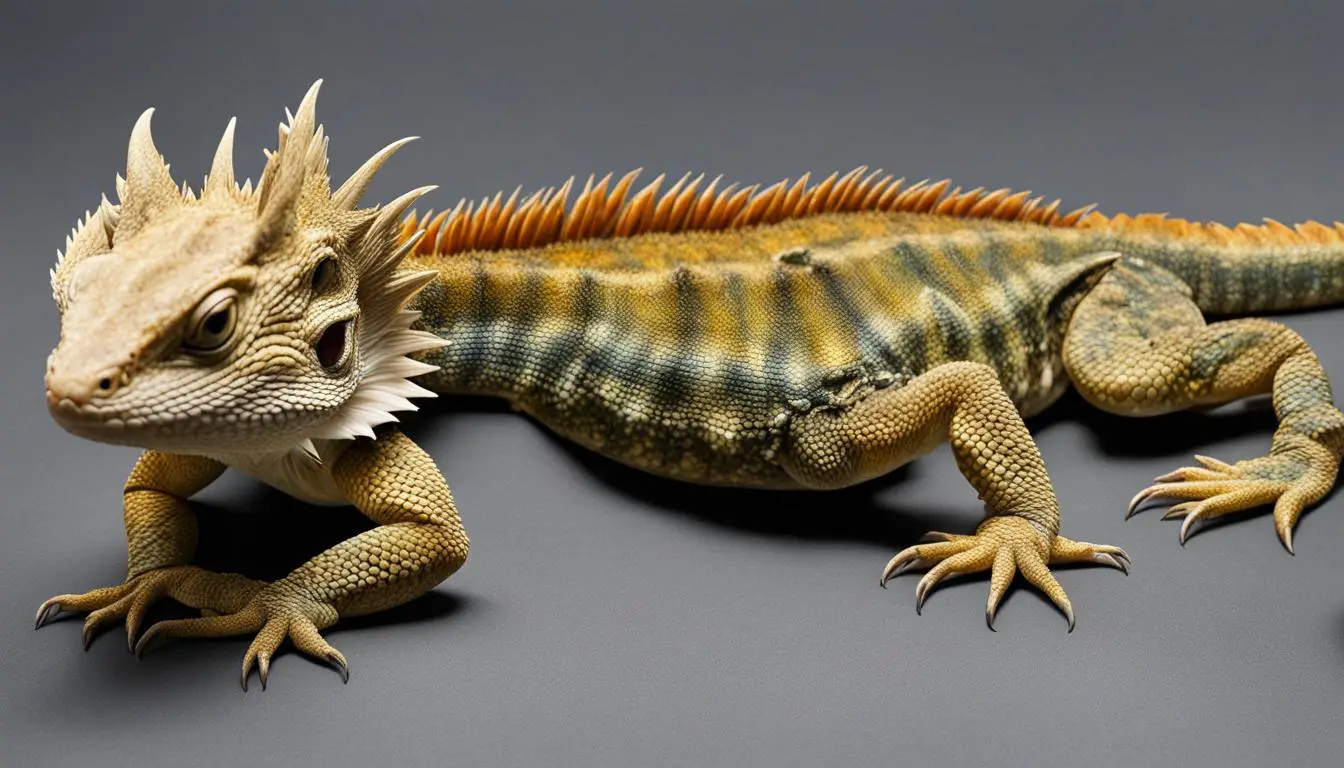Are you considering a pet lizard and torn between choosing a Rankin Dragon or a Bearded Dragon? Look no further! In this comprehensive guide, we will explore the key differences between these two popular reptile companions, helping you make an informed decision.
Rankin’s Dragons and Bearded Dragons both have their unique traits, making them fascinating pets. By understanding their disparities in size, temperament, care requirements, and more, you can determine which dragon is the perfect fit for you.
Key Takeaways:
- Rankin Dragons and Bearded Dragons differ in size, with Bearded Dragons being larger on average.
- Temperament-wise, Rankin Dragons are sociable and can coexist with other reptiles, while Bearded Dragons are more territorial and prefer to live alone.
- The care requirements for both species are similar, focusing on proper habitat setup, diet, and temperature control.
- Bearded Dragons generally have a longer lifespan compared to Rankin Dragons.
- Rankin Dragons primarily rely on an insect and leafy greens diet, while Bearded Dragons have a wider range of food options.
Size Difference: Rankin Dragon vs Bearded Dragon
When comparing Rankin’s Dragons and Bearded Dragons, one of the most notable differences between these two popular pet lizard species is their size. Understanding the size difference is essential in ensuring you provide the appropriate space and enclosure requirements for each dragon.
Bearded Dragons:
Bearded Dragons are larger in size, typically measuring 18-24 inches long on average. Their impressive length and robust build make them a substantial addition to your reptile family.
Rankin’s Dragons:
In contrast, Rankin’s Dragons are smaller reptiles, typically reaching lengths of 10-12 inches. While they may not be as massive as Bearded Dragons, they still hold unique beauty and charm in their smaller form.
The disparity in size between Rankin’s Dragons and Bearded Dragons can influence the amount of space and enclosure requirements needed for each species. It’s crucial to provide a comfortable and appropriate habitat allowing your pet dragon to thrive and exhibit natural behaviors.
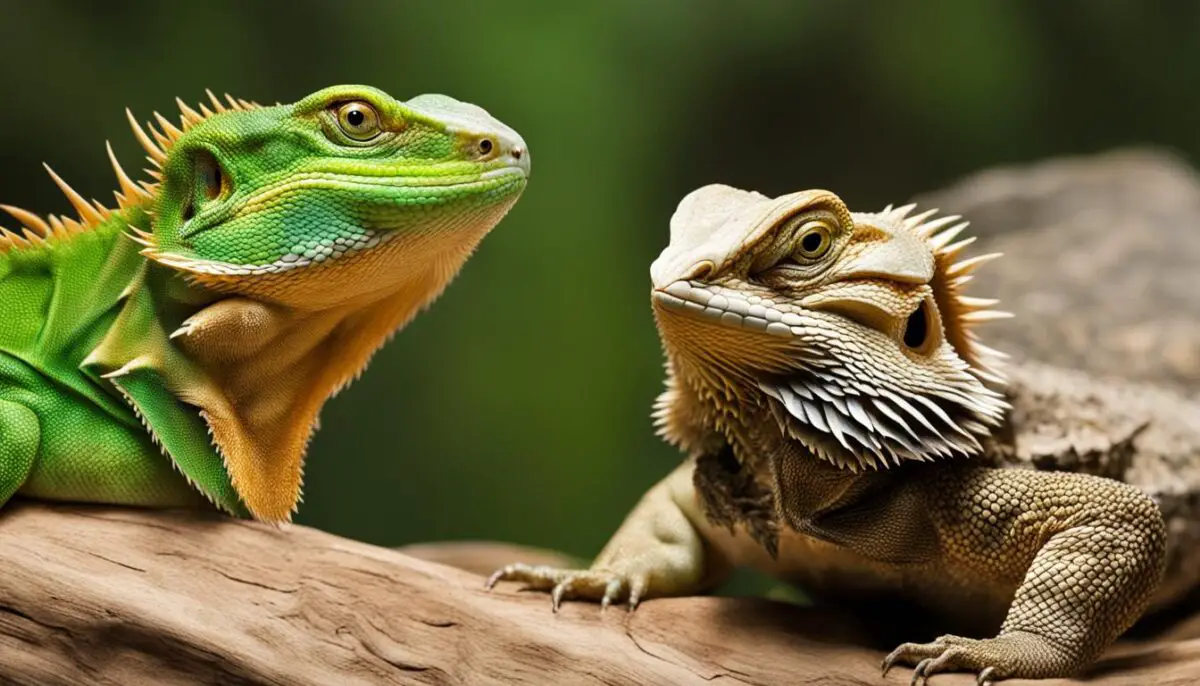
Temperament: Rankin Dragon vs Bearded Dragon
The temperament of Rankin’s Dragons and Bearded Dragons differ significantly, which is an important factor to consider when deciding on a reptile companion.
Rankin’s Dragons are known for their sociable nature and their ability to coexist harmoniously with other reptiles. This sociability makes them more suitable for group housing arrangements where they can thrive in the company of others.
Bearded Dragons, on the other hand, exhibit a more territorial temperament and often prefer to be housed alone. They require their own private space and may display aggression towards other dragons if forced to share their territory.
Understanding the temperament of each species is crucial for creating a conducive and harmonious living environment for your pet reptile. Whether you choose a Rankin Dragon or a Bearded Dragon, it’s important to provide them with the appropriate housing and social dynamics that align with their unique temperament.
Here’s a comparison of the temperament of Rankin’s Dragons and Bearded Dragons:
Rankin Dragon:
- Sociable and friendly
- Can coexist with other reptiles
- Tends to have a calm demeanor
Bearded Dragon:
- More territorial and prefers solitary living
- May exhibit aggression towards other dragons
- Requires its own private space
Understanding the temperament of your pet is essential for their overall well-being and happiness. Providing an environment that suits their social needs will contribute to a healthy and contented life for your Rankin Dragon or Bearded Dragon.
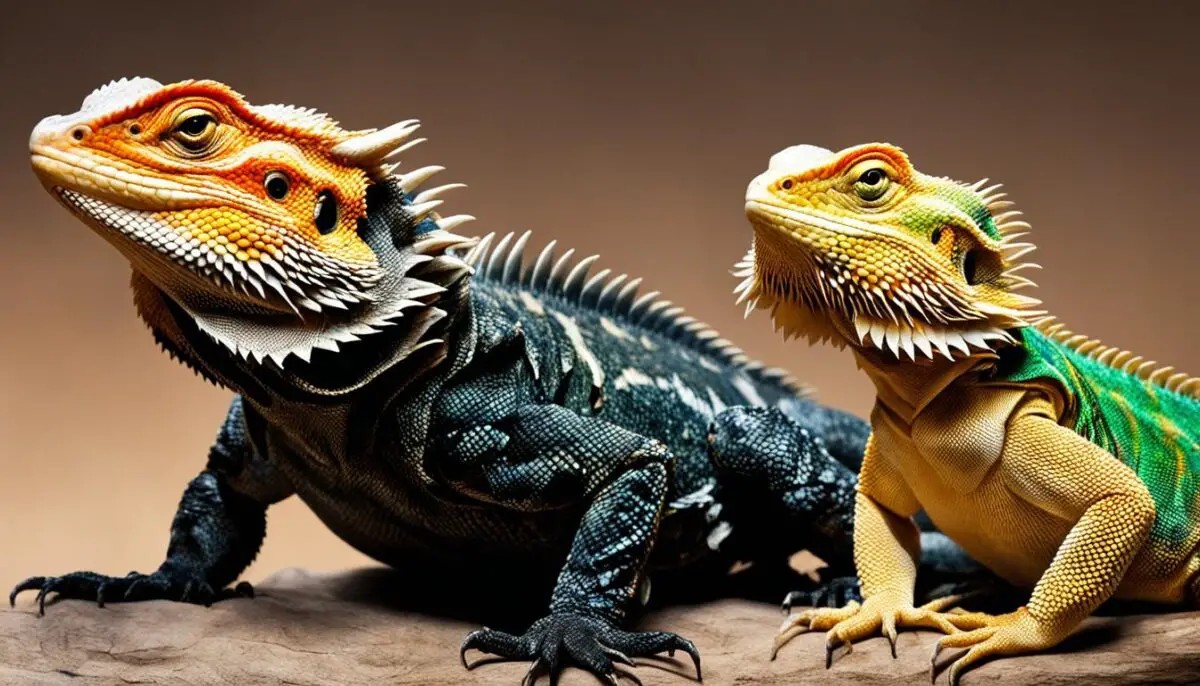
Care Requirements: Rankin Dragon vs Bearded Dragon
When it comes to caring for Rankin’s Dragons and Bearded Dragons, the care requirements are quite similar. Both species require specific considerations in terms of their habitat setup and diet in order to thrive.
Habitat Setup
Both Rankin’s Dragons and Bearded Dragons require proper habitat setup to ensure their well-being. Here are the key elements to consider:
- Enclosure: While Bearded Dragons may need larger enclosures due to their size, Rankin’s Dragons can thrive in slightly smaller habitats. It’s important to provide enough space for the dragons to move around comfortably.
- UVB Lighting: Both species require access to UVB lighting to meet their vitamin D needs. This can be provided through specialized reptile lighting fixtures.
- Temperature and Humidity: Maintaining the correct temperature and humidity levels is essential for the dragons’ health. A temperature gradient should be established in the enclosure, with a warm basking spot and cooler areas. Humidity levels should be monitored and adjusted according to the specific needs of each species.
Diet
Proper nutrition is crucial for the well-being of Rankin’s Dragons and Bearded Dragons. Here are the key aspects of their diet:
- Insects: Both species are insectivores and require a diet rich in insects such as crickets, mealworms, and roaches. These should be gut-loaded with nutritious food before being offered to the dragons.
- Leafy Greens: Both Rankin’s Dragons and Bearded Dragons benefit from a variety of leafy greens in their diet, such as collard greens, kale, and dandelion greens. These provide essential vitamins and minerals.
To ensure a balanced diet, it is recommended to offer a variety of insects and greens to both Rankin’s Dragons and Bearded Dragons. Feeding schedules may vary depending on the age and size of the dragons.
Providing a suitable habitat and a well-rounded diet is key to keeping both Rankin’s Dragons and Bearded Dragons healthy and happy.
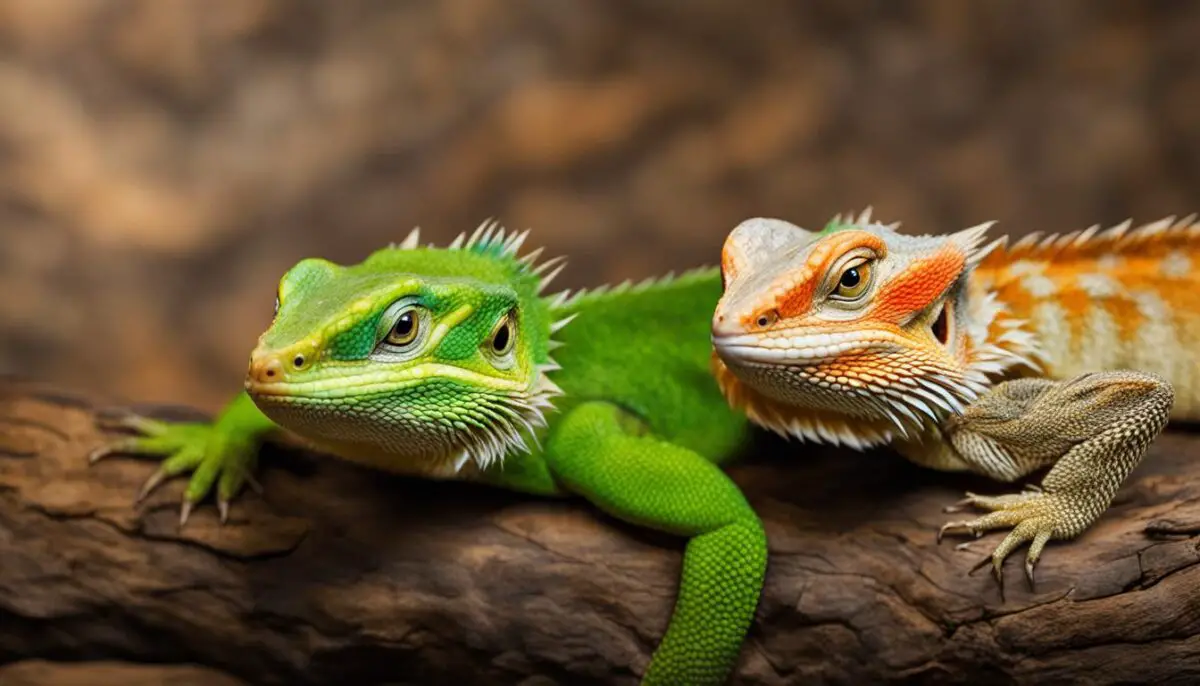
| Species | Average Lifespan |
|---|---|
| Bearded Dragon | 10-15 years |
| Rankin Dragon | 6-10 years |
Diet: Rankin Dragon vs Bearded Dragon
Rankin’s Dragons and Bearded Dragons have distinct dietary preferences that reflect their natural feeding behaviors and nutritional needs.
Rankin’s Dragons: These lizards are primarily insectivorous, meaning their diet consists mainly of insects. However, they also benefit from the inclusion of leafy greens in their meals to provide essential vitamins and fiber. A balanced diet for Rankin’s Dragons includes a variety of small insects, such as crickets and mealworms, along with an assortment of leafy greens like collard greens, dandelion greens, and mustard greens. These leafy greens not only offer hydration but also aid in digestion and overall gut health.
Bearded Dragons: Unlike Rankin’s Dragons, Bearded Dragons are omnivores, meaning they eat both animal protein and plant matter. They have a more diverse diet that includes insects, leafy greens, and occasional fruits. The primary source of animal protein for Bearded Dragons is insects such as crickets, roaches, and mealworms. They also enjoy eating leafy greens such as kale, collard greens, and Swiss chard, which offer vital nutrients and hydration. Additionally, Bearded Dragons can benefit from the occasional treat of fruits like blueberries, apples, and strawberries, which provide added vitamins and antioxidants.
To ensure optimal health and well-being for both Rankin’s Dragons and Bearded Dragons, it is crucial to provide a well-balanced and varied diet that meets their specific dietary requirements. A nutritional imbalance can lead to various health issues, including metabolic bone disease and vitamin deficiencies.
Proper nutrition plays a vital role in the overall health and longevity of pet dragons. Providing a diverse diet that mimics their natural feeding habits is essential for their well-being.
For a visual comparison of the recommended diet for Rankin’s Dragons and Bearded Dragons, refer to the table below:
| Rankin’s Dragons | Bearded Dragons |
|---|---|
| Insects (crickets, mealworms) | Insects (crickets, roaches, mealworms) |
| Leafy Greens (collard greens, dandelion greens, mustard greens) | Leafy Greens (kale, collard greens, Swiss chard) |
| Fruits (blueberries, apples, strawberries) |
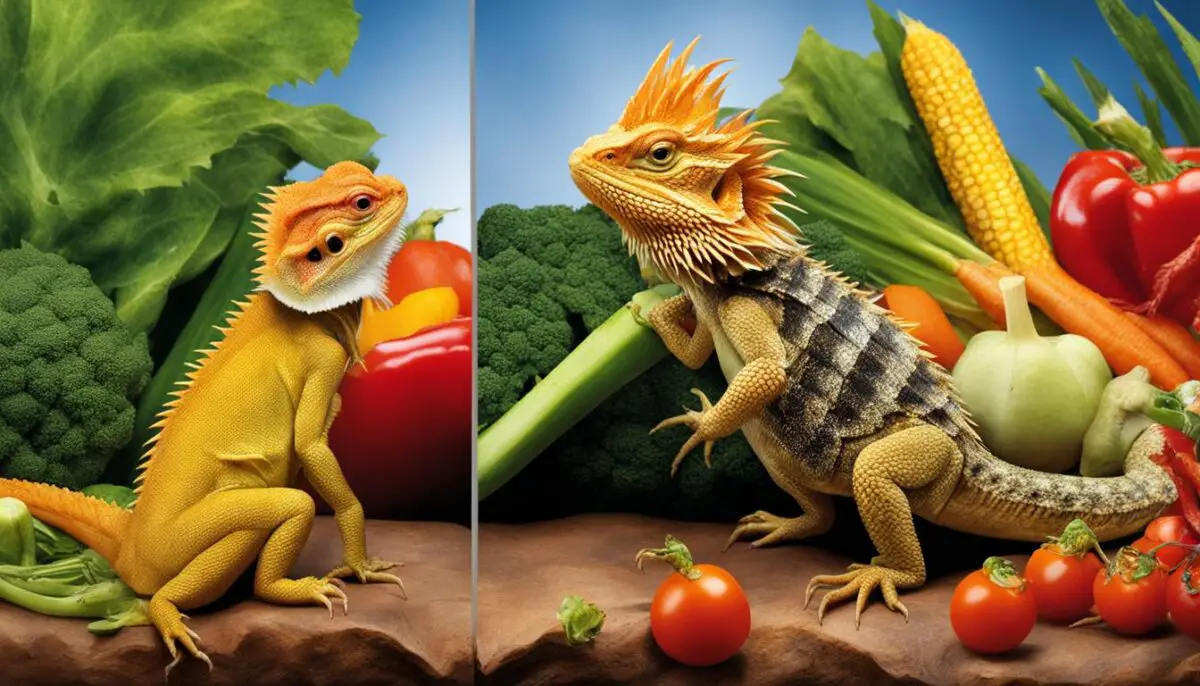
By providing a balanced and varied diet that meets the specific dietary needs of Rankin’s Dragons and Bearded Dragons, you can ensure their overall health and well-being.
Housing and Enclosure Needs: Rankin Dragon vs Bearded Dragon
When it comes to housing and enclosure needs, both Rankin’s Dragons and Bearded Dragons have similar requirements to ensure their well-being. Providing a suitable habitat with the right environmental conditions is essential for these reptiles to thrive.
First and foremost, both species need UVB lighting to mimic natural sunlight and support their overall health. UVB lighting aids in the production of Vitamin D, which is crucial for calcium absorption and preventing metabolic bone disease.
Temperature control is another critical factor in creating the ideal habitat for Rankin’s Dragons and Bearded Dragons. Both species require a temperature gradient within their enclosures, ranging from 90-95°F on the warm end and 75-85°F on the cooler end. This allows them to regulate their body temperature and stay comfortable.
Proper humidity levels are also important for these dragons. Aim for a humidity level of 30-40% for Rankin’s Dragons and 20-30% for Bearded Dragons. Providing a humid hide or misting their enclosures can help maintain optimal humidity levels and support their overall health.
Habitat Size
However, due to their size difference, Bearded Dragons may require larger enclosures compared to Rankin’s Dragons. Ensuring adequate space is essential for their physical and mental well-being. Bearded Dragons, being larger reptiles, need enclosures with ample room to move around, bask, and explore their surroundings.
Rankin’s Dragons, being smaller, can thrive in slightly smaller habitats. While they still need space to roam and climb, their enclosure size can be adjusted accordingly without compromising their well-being.
Building or purchasing an enclosure that meets the specific size requirements for each species is crucial. It should provide enough space for them to exhibit natural behaviors, such as basking, burrowing, climbing, and exploring.
To help you visualize the differences in enclosure size, here’s a comparison table:
| Species | Enclosure Size |
|---|---|
| Rankin’s Dragon | 40-50 gallons |
| Bearded Dragon | 75-120 gallons |
Table: Comparison of enclosure sizes for Rankin’s Dragons and Bearded Dragons.
By providing the appropriate housing and enclosure needs, you can ensure a comfortable and thriving environment for both Rankin’s Dragons and Bearded Dragons.
Conclusion
In conclusion, when deciding between a Rankin Dragon and a Bearded Dragon, it’s important to consider your preferences and lifestyle. If you’re looking for a reptile companion that can cohabit with other reptiles, the sociable nature of the Rankin Dragon makes it a great choice. On the other hand, if you prefer a solitary reptile pet, the larger size and more territorial tendencies of the Bearded Dragon may be a better fit.
Regardless of which dragon you choose, providing proper care, attention, and a suitable environment is crucial for their health and well-being. Both species require UVB lighting, controlled temperature, and humidity in their enclosures. Additionally, a balanced diet consisting of insects and leafy greens is necessary to support their nutritional needs.
Whether you opt for a Rankin Dragon or a Bearded Dragon, these fascinating reptiles can make wonderful additions to your family. Take the time to research and understand their specific requirements to ensure a happy and fulfilling life for your chosen dragon companion.
FAQ
What is the difference in size between Rankin’s Dragons and Bearded Dragons?
Bearded Dragons are larger, measuring 18-24 inches long on average, while Rankin’s Dragons are smaller, reaching lengths of 10-12 inches.
How do the temperaments of Rankin’s Dragons and Bearded Dragons differ?
Rankin’s Dragons are sociable and can coexist with other reptiles, while Bearded Dragons are more territorial and prefer to be housed alone.
What are the care requirements for Rankin’s Dragons and Bearded Dragons?
Both species require UVB lighting, controlled temperature and humidity in their enclosure, as well as a balanced diet consisting of insects and leafy greens.
What is the difference in lifespan between Rankin’s Dragons and Bearded Dragons?
Bearded Dragons generally live 10-15 years on average, while Rankin’s Dragons have a lifespan of 6-10 years.
What do Rankin’s Dragons and Bearded Dragons eat?
Rankin’s Dragons primarily eat insects and leafy greens, while Bearded Dragons are omnivores and have a broader diet that includes insects, leafy greens, and occasional fruits.
What are the housing and enclosure needs for Rankin’s Dragons and Bearded Dragons?
Both species require UVB lighting, temperature control, and appropriate humidity levels. However, Bearded Dragons may require larger enclosures compared to Rankin’s Dragons due to their size.

